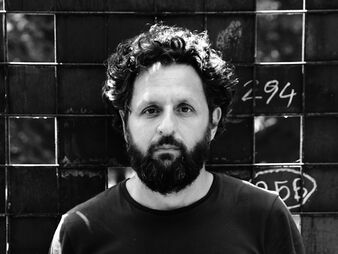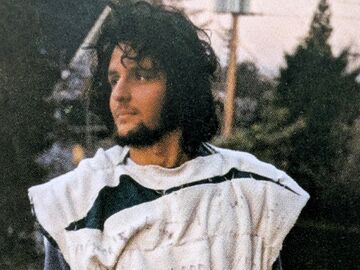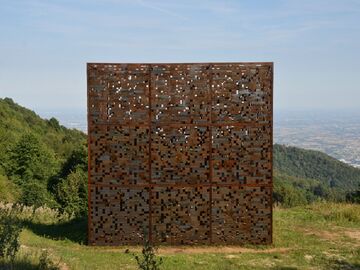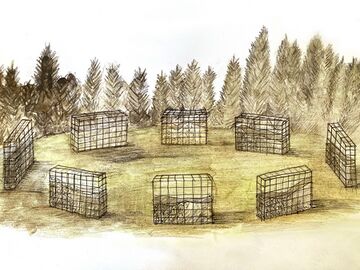Difference between revisions of "Alberto Frigo"
Arutanedram (talk | contribs) |
Arutanedram (talk | contribs) |
||
| Line 14: | Line 14: | ||
==Background== | ==Background== | ||
| − | Having moved to Canada in 2000 | + | As young artist Frigo became quickly fascinated with filming his action paintings. Having moved to Canada in 2000 he began using 16 mm cameras to film his everyday life as a homeless in downtown Vancouver. Feeling overwhelmed from all the editing work Frigo sewed all his journals in a poncho and undertook a road trip across the americas. If the purpose of the trip was to get back to pen and paper and avoid the use of technology the result was that upon returning to Canada Frigo began to conceive the idea of a digital system to document his life and the way the surroundings affect it. |
| − | Having moved back to Europe Frigo | + | Having moved back to Europe in 2002 Frigo was invited to work as guest artist at the [[Interactive Institute]]. There he developed wearable computers to record life 24/7 but was ultimately inspired by [[Lev Manovich]] reading of [[Dziga Vertov]]'s work and began to document life using different media to record multiple aspects of reality. After a brief collaboration with [[Krzysztof Wodiczko]] Frigo became project leader at M.I.T. Design Lab. He later taught database aestethics at Sodertorn University where he obtained a PhD in Critical and Cultural Theory. |
<gallery mode=packed heights=180px> | <gallery mode=packed heights=180px> | ||
| Line 24: | Line 24: | ||
==Works== | ==Works== | ||
| − | Officially starting in 2004 Frigo has devised 36 methods to document life continuosly and until 2040 when he will be 60. His most famous work consists in photographing every object his right hand uses | + | Officially starting in 2004 Frigo has devised 36 methods to document life continuosly and until 2040 when he will be 60. His most famous work consists in photographing every object his right hand uses, a method inspisred by [[Georges Perec]] and the O.U.L.I.P.O. movement in general. After been awarded at [[Ars Electronica]] in 2006, Frigo's photographic work has been shown in museums and featured in the news around the world. |
| − | In | + | In 2016 Frigo collaborated with Hasselblad Foundation and [[Peter Weibel]] on the topic of surveillance art. For the purpose he presented a large scale installation comprising of 144 photographic panels. In these panels one month worth of all the objects his right hand has used since 2004 were diplayed with each photographic line representing a day and each line of panels a year. By 2040 the installation will be a perfect square of 12 by 12 meters with one million photos of all the objects an individual has used throughout his adult life, namely from the age of 24 to the age of 60. |
<gallery mode=packed heights=180px> | <gallery mode=packed heights=180px> | ||
Alberto Frigo Hasselblad Foundation.jpg|Frigo's Square | Alberto Frigo Hasselblad Foundation.jpg|Frigo's Square | ||
Alberto Frigo's cube.jpg|Frigo's Cube | Alberto Frigo's cube.jpg|Frigo's Cube | ||
| + | Alberto Frigo's Lebanrat.jpg|Frigo's Circle | ||
</gallery> | </gallery> | ||
| + | |||
| + | In 2018 Frigo conceived the idea of a giant 7.6 meters iron cube. Since there are 432 months in 36 years and 36 are his works the sculpture is made of 15.552 pixels. Each pixel then corresponds to a month production of one his 36 works visitors can retreive by recreating the pattern on the screen. The sculpture was ulimately realized on Mount Novegno, 100 kilometers of Venice and 1000 meters above the sea level. | ||
| + | |||
| + | Upon completing his cube and halfway into his life project, in 2024 Frigo began to work on the idea of a memory theater in which every architectural element corresponds to one of his 36 life-works. Inspired by the circular camps of hunter-gatherers he began to work on a 32.4 meters circle in a hurricane devastated forest in his native highland. In this circle visitors are able to reconstruct the theater using augmented reality. | ||
==Related== | ==Related== | ||
Revision as of 05:23, 22 May 2025
 Alberto Frigo | |
| Born |
July 21, 1979 Asiago, Italy |
|---|---|
Alberto Frigo (1979) is an artist known for having photographed every object his right hand has used since September 2003. In a 36 year project he has been tracking 36 aspects of his life and surroundings. By 2040 the project will include 1,000,000 photos of all the objects he used, 432,000 of his dreams, 93,312 of the songs he heard, 25,950 of his thoughts, 77,760 of the public places he visited, 3,456 portraits of the people he met, 38,880 ideas coming to his head, 6,912 collages of the trash he found on the sidewalk, 10,368 shapes of the clouds he observed and much more.
Contents
Background
As young artist Frigo became quickly fascinated with filming his action paintings. Having moved to Canada in 2000 he began using 16 mm cameras to film his everyday life as a homeless in downtown Vancouver. Feeling overwhelmed from all the editing work Frigo sewed all his journals in a poncho and undertook a road trip across the americas. If the purpose of the trip was to get back to pen and paper and avoid the use of technology the result was that upon returning to Canada Frigo began to conceive the idea of a digital system to document his life and the way the surroundings affect it.
Having moved back to Europe in 2002 Frigo was invited to work as guest artist at the Interactive Institute. There he developed wearable computers to record life 24/7 but was ultimately inspired by Lev Manovich reading of Dziga Vertov's work and began to document life using different media to record multiple aspects of reality. After a brief collaboration with Krzysztof Wodiczko Frigo became project leader at M.I.T. Design Lab. He later taught database aestethics at Sodertorn University where he obtained a PhD in Critical and Cultural Theory.
Works
Officially starting in 2004 Frigo has devised 36 methods to document life continuosly and until 2040 when he will be 60. His most famous work consists in photographing every object his right hand uses, a method inspisred by Georges Perec and the O.U.L.I.P.O. movement in general. After been awarded at Ars Electronica in 2006, Frigo's photographic work has been shown in museums and featured in the news around the world.
In 2016 Frigo collaborated with Hasselblad Foundation and Peter Weibel on the topic of surveillance art. For the purpose he presented a large scale installation comprising of 144 photographic panels. In these panels one month worth of all the objects his right hand has used since 2004 were diplayed with each photographic line representing a day and each line of panels a year. By 2040 the installation will be a perfect square of 12 by 12 meters with one million photos of all the objects an individual has used throughout his adult life, namely from the age of 24 to the age of 60.
In 2018 Frigo conceived the idea of a giant 7.6 meters iron cube. Since there are 432 months in 36 years and 36 are his works the sculpture is made of 15.552 pixels. Each pixel then corresponds to a month production of one his 36 works visitors can retreive by recreating the pattern on the screen. The sculpture was ulimately realized on Mount Novegno, 100 kilometers of Venice and 1000 meters above the sea level.
Upon completing his cube and halfway into his life project, in 2024 Frigo began to work on the idea of a memory theater in which every architectural element corresponds to one of his 36 life-works. Inspired by the circular camps of hunter-gatherers he began to work on a 32.4 meters circle in a hurricane devastated forest in his native highland. In this circle visitors are able to reconstruct the theater using augmented reality.
Related
- Erkki Kurenniemi's Virtual persona
- Buckminster Fuller's Dymaxion Chronofile
- Tehching Hsieh's One Year Performance
- Vivian Maier's Archive
Links
Press
- Alberto Frigo Encodes His Life As Iron Pixels, Designboom, 2024
- Francesco Amorosino, La fotografia nell'era dell'ipercontrollo, Casa Editrice Emuse, 2024
- Peter Hall & Patricio Dávila, Critical Visualization, Bloomsbury Publishing, 2022
- David Jones, Visual Culture and the Forensic: Culture, Memory, Ethics, Routledge Edition, 2022
- Henriette Lind, S-v-i-m-l-e-n-d-e-, Politiken, 2022
- Andrea Mennicken & Robert Salais, The New Politics of Numbers, Springer Int., 2021
- Thorben Mämecke, Das quantifizierte Selbst, Transcript Edition, 2021
- Paul Goodwin, Something Doesn’t Add Up, Profile Books Ltd, 2021
- Svea Braeunert, Sarah Tuck & Louise Wolthers, (W)archives, Sternberg Press, 2021
- Florian Mehnert, Datismus Versus Freihet, BvD-News, 2020
- Margaux Dussert, Par amour du trolling ou par quête de sens, L'ADN, 2019
- Toft Tanya, Digital Dynamics in Nordic Contemporary Art, Chicago University Press, 2019
- Sigtryggur Ari, Aldrei úr augnsýn, DV, 2018
- Desjardins, Images partagées et autres selfies, Mowwgli, 2017
- Samantha Deman, Special Mobile Art, Arts Hebdo Media, 2017
- Mark Hoogendoorn & Burkhardt Funk, Machine Learning for the Quantified Self, Springer Int., 2017
- Susan Flynn, Antonia Mackay , Spaces of Surveillance, Palgrave Macmillan, 2017
- Aude Launay, Watched! Surveillance, Art and Photography, Zero Deux, 2017
- Deborah Lupton, The Quantified Self, Polity Press, 2016
- Tamar Sharon & Dorien Zandbergen, From data fetishism to quantifying selves, New Media & Society, 2016
- David Jones, Installation Art and the Practices of Archivalism, Routledge Edition, 2016
- Rune Gade, Overvågningens vaesen, Information, 2016
- Birgit Richard, Hamster-Hipster-Handy, Kerber Edition, 2015
- Die Welt, Wie das Handy unseren Lebenswandel bestimmt, 2015
- Abel van Gijlswijk, Alberto maakt 36 jaar lang foto’s van alles wat hij met zijn rechterhand doet, Vice Magazine, 2014
- Sherry Turkle, Alone Together, Best Books, 2011
- Rob Kitchin & Martin Dodge, Code/space: Software and Everyday Life, MIT Press, 2011
- Outi Remes & Pam Skelton, Conspiracy Dwellings, Scholars Publishing, 2010
- Dominique Moulon, Art Contemporain et Nouveaux Médias, Sentier d'Art Edition, 2010
- Hannes Leopoldseder & Gerfried Stocker, CyberArts 2006, Hatje Cantz Publishers, 2006




